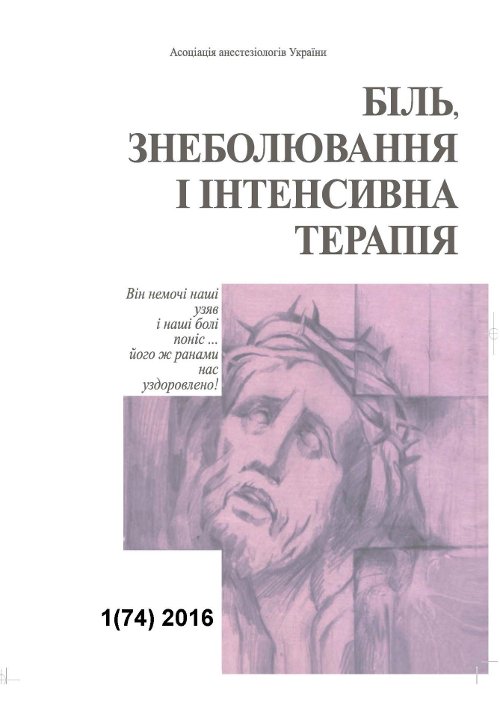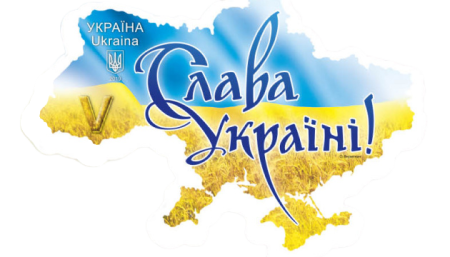Роль рiзних груп аналгетикiв в безпецi периоперациїного знеболювання онкохiрургiчних хворих
DOI:
https://doi.org/10.25284/2519-2078.1(74).2016.83768Ключові слова:
омнопон, декскетопрофен, налбуфiн, iммуна система, нирково-клiтинний ракАнотація
У статтi наводяться результати ослiдження впливу периоперацiйного знеболювання аналгетиками омнопоном, декскетопрофеном та налбуфiном на деякi показники стану клiтинної ланки iмунної системи у хворих на рак нирки, яким проведена нефректомiя або резекцiя нирки. Встановлено, що при використаннi декскетопрофену та налбуфiну пiсля операцiйна iмуносупресiя носить менш виражений характер у порiвняннi з використанням омнопону, що проявляється бiльш стабiльним рiвнем iмунокомпетентних клiтин, збiльшенням кiлькостi натуральних кiлерних клiтин i їх цитотоксичної активностi.
Посилання
Ogawa K, Hirai M, Katsube T, et al. (2000) Suppression of cellular immunity by surgical stress. Surgery., 127:329–36. https://doi.org/10.1067/msy.2000.103498
Page GG. Surgery-induced immunos uppression and postoperative pain management (2005). AACN Clin Issues, 16:302–9. https://doi.org/10.1097/00044067-200507000-00004
Kurosawa S, Kato M. (2008) Anesthetics, immune cells, and immune responses. J Anesth; 22:263–277. https://doi.org/10.1007/s00540-008-0626-2
Michael D., Brigitte V. (2004) Surgical trauma: hyperinflammation versus immunosuppression? Langenbeck's ArchSurg, 389:475–484. https://doi.org/10.1007/s00423-004-0472-0
Shimaoka M., Hosotsubo K., Sugimoto M. et al. (1998) The influence of surgical stress on T cells: enhancement of early phase lymphocyte activation. AnesthAnalg, 87:1431–5. https://doi.org/10.1213/00000539-199812000-00043
Гриневич Ю.А., Барабой В.А. (2010) Новообразовательный процесс и стрессовая патология. К: Логос, 155 с.
Meiler S. (2006) Long-term outcome after anesthesia and surgery: remarks on the biology of a newly emerging principle in perioperative care. Anesthesiology Clin N Am., 24:255–278. https://doi.org/10.1016/j.atc.2006.03.002
Homburger J., Meiler S. (2006) Anesthesia drugs, immunity, and long-term outcome. CurrOpinAnesthesiol, 19: 423–428. https://doi.org/10.1097/01.aco.0000236143.61593.14
Kusmartsev S., Gabrilovich D. (2002) Immature myeloid cells and cancer-associated immune suppression. Cancer ImmunolImmunother, 51:293–8. https://doi.org/10.1007/s00262-002-0280-8
Serafini P., De Santo C., Marigo I., et al. (2004) Derangement of immune responses by myeloid suppressor cells. Cancer Immunol Immunother, 53:64–72. https://doi.org/10.1007/s00262-003-0443-2
Procopio M.A., Rassias A.J., DeLeo J.A. et.al. The in vivo effects of general and epidural anesthesia on human immune function. AnesthAnalg 2001;93:460–5. https://doi.org/10.1097/00000539-200108000-00044
Al-Hasani R., Bruchas M. (2011) Molecular mechanisms of opioid Receptor-dependent signaling and behavior. Anesthesiology, 115:1363–1381. https://doi.org/10.1097/aln.0b013e318238bba6
Martin J., Koodie L., Krishnan A., et al. (2010) Chronic morphine administration delays wound healing by inhibiting immune cell recruitment to the wound site. Am J Pathol, 176:786–799. https://doi.org/10.2353/ajpath.2010.090457
Yuan F., Xiaozhou H., Yilin Y. (2012) Current Research on Opioid Receptor Function. CurrDrugTargets, 13(2): 230–246. https://doi.org/10.2174/138945012799201612
Welters I., Menzebach A., Goumon Y., et al. (2000) Morphine suppresses complement receptor expression, phagocytosis, and respiratory burst in neutrophils by a nitric oxide and μ3 opiate receptor-dependent mechanism. J Neuroimmunol, 111:139–145. https://doi.org/10.1016/s0165-5728(00)00401-x
Mojadadi S., Jamali A., Khansarinejad B., et al. (2009) Acute morphine administration reduces cell-mediated immunity and induces reactivation of latent herpes simplex virus type 1 in BALB/c mice. CellMolImmunol, 6:111–116.
Börner C., Warnick B., Smida M., et al. (2011) Mechanisms of opioid-mediated inhibition of human T cell receptor signaling. J Immunl, 183:882–889. https://doi.org/10.4049/jimmunol.0802763
Wang J., Barke R., Charboneau R., et al. (2003) Morphine negatively regulates interferon-gamma promoter activity in activated murine T cells through two distinct cyclic AMP-dependent pathways. JBiolChem, 278:37622–37631. https://doi.org/10.1074/jbc.m301224200
Börner C., Kraus J., Bedini A., et al (2008). T-cell receptor/CD28-mediated activation of human T lymphocytes induces expression of functional μ-opioid receptors. MolPharmacol, 74:496–504. https://doi.org/10.1124/mol.108.046029
Sacerdote P. (2008) Opioid-induced immunosuppression. CurrOpin Support Palliat Care, 2:14–18. https://doi.org/10.1097/spc.0b013e3282f5272e
Sjödahl R.(2001) Nonsteroidal anti-inflammatory drugs and the gastrointestinal tract. Extent, mode, and dose dependence of anticancer effects. Am J Med, 110(1A):66-69. https://doi.org/10.1016/s0002-9343(00)00646-x
González-Pérez А., Luis A. Rodríguez G., López-Ridaura R. (2003) Effects of non-steroidal anti-inflammatory drugs on cancer sites other than the colon and rectum: a meta-analysis. BMC Cancer, 3:28. Р. 124-134. https://doi.org/10.1186/1471-2407-3-28
Бережная Н.М., Чехун В. Ф. Иммунология злокачественного роста. Киев, «Наукова думка», 2005., С. 125-128.
Murphy K. Janeway’s Immunobiology, Garland Science; 8 edition 2012.
Kurosawa Sh., Kato M. (2008) Anesthetics, immune cells, and immune responses. J Anesth, 22:263–277. https://doi.org/10.1007/s00540-008-0626-2
Mizota T., Tsujikawa H., Shoda T. (2013) Dual modulation of the T-cell receptor-activated signal transduction pathway by morphine in human T lymphocytes. J Anesth, 27:80–87. https://doi.org/10.1007/s00540-012-1472-9
Hashiguchi S., Morisaki H., Kotake Y., Takeda J. (2005) Effects of morphine and its metabolites on immune function in advanced cancer patients. J.Clin. Anesthesia, 17: 575–580. https://doi.org/10.1016/j.jclinane.2005.03.004
Munegowda M., Xua S., Freywaldb A.et. al. (2012) CD4+Th2 cells function alike effector Tr1 and Th1 cells through the deletion of a single cytokine IL-6 and IL-10 gene, Molecular Immunology, 51:143–149. https://doi.org/10.1016/j.molimm.2012.02.120
Jiang J. Dingledine R. (2013) Prostaglandin receptor EP2 in the crosshairs of anti-inflammation, anti-cancer, and neuroprotection, Trends Pharmacol Sci, 34(7): 413–423. https://doi.org/10.1016/j.tips.2013.05.003
Shakhar G., Ben-Eliyahu S. (2003) Potential prophylactic measures against postoperative immunosuppression: Could they reduce recurrence rates in oncological patients? AnnSurgOncol, 10(8): 972–92. https://doi.org/10.1245/aso.2003.02.007
Page G.G., Ben-Eliyahu S. (2002) Indomethacin attenuates the immunosuppressive and tumor-promoting effects of surgery. J Pain, 3:301–8. https://doi.org/10.1054/jpai.2002.125184
Gutkin D., Shurin M. (2014) Clinical evaluation of systemic and local immune responses in cancer: time for integration. Cancer Immunol Immunother, 63(1):45–57. https://doi.org/10.1007/s00262-013-1480-0
Forget P., Collet V., Lavand’homme P., Kock de M. (2010) Does analgesia and condition influence immunity after surgery? Effects of fentanyl, ketamine and clonidine on natural killer activity at different ages. Eur J Anaesthesiol., 27:233-240. https://doi.org/10.1097/eja.0b013e32832d540e
Sacerdote P., Bianchi M., Gaspani L. et. al. (2000) The Effects of Tramadol and Morphine on Immune Responses and Pain After Surgery in Cancer Patients. Anesthesia&Analgesia, 90(6):1411-1414. https://doi.org/10.1097/00000539-200006000-00028
##submission.downloads##
Опубліковано
Як цитувати
Номер
Розділ
Ліцензія
Авторське право (c) 2016 И. И. Лесной, Р. И. Сидор, Н. Н. Храновская, О. В. Скачкова, М. О. Катриченко

Ця робота ліцензується відповідно до Creative Commons Attribution-NonCommercial 4.0 International License.
Автори, які публікуються у цьому журналі, погоджуються з наступними умовами:
a. Автори залишають за собою право на авторство своєї роботи та передають журналу право першої публікації цієї роботи на умовах ліцензії Creative Commons Attribution-NonCommercial 4.0 International License, котра дозволяє іншим особам вільно розповсюджувати опубліковану роботу з обов'язковим посиланням на авторів оригінальної роботи та першу публікацію роботи у цьому журналі.
b. Автори мають право укладати самостійні додаткові угоди щодо неексклюзивного розповсюдження роботи у тому вигляді, в якому вона була опублікована цим журналом (наприклад, розміщувати роботу в електронному сховищі установи або публікувати у складі монографії), за умови збереження посилання на першу публікацію роботи у цьому журналі.
c. Політика журналу дозволяє і заохочує розміщення авторами в мережі Інтернет (наприклад, у сховищах установ або на особистих веб-сайтах) рукопису роботи, як до подання цього рукопису до редакції, так і під час його редакційного опрацювання, оскільки це сприяє виникненню продуктивної наукової дискусії та позитивно позначається на оперативності та динаміці цитування опублікованої роботи (див. The Effect of Open Access).








